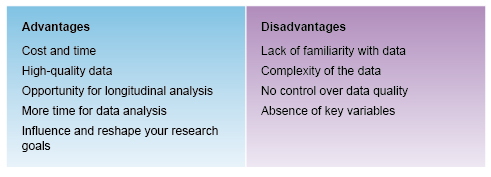6 The advantages and limitations of secondary data
One of the key characteristics of secondary data is that the researcher did not participate in the collection of the data and that it was collected by someone else, who used it for other purposes. This gives rise to several advantages as well as drawbacks.

- Compared to primary data, secondary data provides a time-efficient and easy to obtain source of information for your project by saving the time and cost required of conducting the research yourself. Being generally quicker to collect than primary data allows more time for analysis.
- By utilising existing databases, you may access data that would otherwise not be possible for you to collect. These databases are particularly helpful if your project question requires you to compare multiple locations or organisations.
- Secondary data drawn from credible sources are sometimes more reliable than those collected by yourself, as large organisations such as the World Bank have greater financial and human resources to conduct large-scale data collection, such as longitudinal analysis, which is useful when making comparisons over time.
- Finally, one of the main advantages of using secondary data is how it can influence and re-shape the business issue you are investigating, as well as steering you towards any primary research you may be required to conduct for your change management project.
However, secondary data also has its disadvantages. The first and biggest problem is that most secondary data is collected by someone else, usually for different purposes, so such data may not be suitable for directly answering your project questions. The lack of familiarity with the data means that you will need time to fully understand it.
For your own project you may have to search quite a few databases before you find appropriate ones. Also, access to secondary data might be difficult, as data collected for commercial purposes is often restricted or you may have to pay to access it − for example, downloading the latest Mintel industry report relevant to your sector may cost in excess of £2,000. Finally, the quality and integrity of data obtained from databases from certain websites may be difficult to ensure.

Activity 8 Pros and cons of secondary data
One of the main advantages of using secondary data is how it can influence and re-shape the business issue you are investigating, as well as steering you towards any primary research.
Often, once you have started to explore a particular work problem, other organisational challenges may come to light that were not considered in your initial scope.
Part 1
- Identify two sources of secondary data that you feel are useful in researching your chosen work problem.
- Consider some of the advantages of using your chosen sources and how you might overcome some of the disadvantages.
Feedback
Table 3 offers some examples of sources of secondary data that you could use. The topic of your research will be the determining factor for your decision. For example, if you would like to explore how many people you should hire to strengthen a particular work function in your organisation, looking at the Business Register and Employment Survey may help. If you search online for the Business Register and Employment Survey you will see that these data are accessed via the Office for National Statistics and Nomis official labour market statistics website.
You can therefore argue that this source will offer high quality data. Moreover, this source reports data from a survey conducted annually, which means that you can use this data for longitudinal research. Finally, this source reports on a survey conducted with 82,000 people. This means that you can access a huge volume of data, which can be both an advantage and a disadvantage.
Part 2
The next part of this activity builds on your skills as a reflective practitioner. In the text box below, answer the following questions:
- How can you justify the use of secondary data for your project?
- How has the activity impacted or re-shaped the work problem you are investigating?
